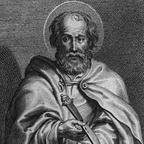 [The following piece of writing is taken from History of Christianity in India (Vol. 1; Bangalore: CHAI, 2001: pp. 65-66) by A. M. Mundadan. Late Dr. A. Mathias Mundadan, C. M. I. (1923-2012), took a Licentiate (M. A.) in Theology from De Nobili College, Pune (1954), a Licentiate and Doctor’s degree in Church History from the Gregorian University, Rome (1960). Fr. Mundadan was professor of Church History, Patrology, Theology and allied subjects at Dharmaram College. He was formerly Rector of Dharmaram College and first President of Dharmaram Pontifical Institute. He published widely into the field of Indian Church History]
[The following piece of writing is taken from History of Christianity in India (Vol. 1; Bangalore: CHAI, 2001: pp. 65-66) by A. M. Mundadan. Late Dr. A. Mathias Mundadan, C. M. I. (1923-2012), took a Licentiate (M. A.) in Theology from De Nobili College, Pune (1954), a Licentiate and Doctor’s degree in Church History from the Gregorian University, Rome (1960). Fr. Mundadan was professor of Church History, Patrology, Theology and allied subjects at Dharmaram College. He was formerly Rector of Dharmaram College and first President of Dharmaram Pontifical Institute. He published widely into the field of Indian Church History]
Read below…
[Two ancient testimonies about the alleged apostolate of St. Bartholomew in India are those of Eusebius of Caesarea (early 4th century) and of St. Jerome (late 4th century). Both these writers refer to this tradition while speaking about the reported visit of Pantaenus to India in the second century. According to Eusebius, Pantaenus “is said to have gone among the Indians, where a report is that he discovered the Gospel according to Matthew among some there who knew Christ, which had anticipated his arrival; Bartholomew, one of the Apostles, had preached to them and had left them the writings of Matthew in Hebrew letters, which writing they preserved until the aforesaid time…” St. Jerome would have that Demetrius, Bishop of Alexandria, sent him to India, at the request of legates of that nation. In India, Pantaenus “found that Bartholomew, one of the twelve Apostles, had preached the advent of the Lord Jesus according to the Gospel of Matthew, and on his return to Alexandria he brought this with him written in Hebrew characters…” Eusebius appears to be not quite sure of the reported fact; Jerome is more categorical [1].
Formerly the consensus of opinion among scholars was against the apostolate of St. Bartholomew in India. Beginning with the Bollandist, Fr. Stiltingus S. J., a few have supported his Indian apostolate. But the vast majority was still sceptical about it [2]. Their main argument is that the India of Eusebius and Jerome should be in fact Ethiopia or Arabia Felix. Two recent studies, one by Fr. Perumalil and the other by Dr. G. M. Moraes, [3] have attempted to show that this argument is untenable. They hold that the Bombay region on the Konkan coast, a region which must have been known after the ancient town Kalyan, was the field of Bartholomew’s missionary activities, and his martyrdom. The town of Kalyan, situated as it is at the north—east end of the Thana Greek, was an ancient port and it is supposed to be the “Kalliana”, the traveller Cosmas Indicopleustes visited in the 6th century as he reports in his Christian Typography [4].
According to Pseudo-Sophronius (7th century), St. Bartholomew preached to the “Indians who are called Happy”, and according to the Greek tradition the Apostle went to “India Felix”. The word Kalyan means “felix” or “happy”, and it is argued that the Kalyan region came to be known to the foreign writers as “India Felix” and its inhabitants, Indians “called the happy”. Perumalil interprets the “Indian Citerior” of Hieronymian Martyrology as western India, and the “India” of the Passio Bartholomei as the Maratha country [5].
Now for the Indian apostolate of St. Bartholomew there is no Indian tradition as we have for St. Thomas. This absence, Dr. Moraes would explain, is due to the fact that the history of the Christians of Bartholomew got intermingled with that of the St. Thomas Christians who came under the control of the Persian Church. And in the tradition of this Church Bartholomew was associated with Armenia and not with India. Fr. Perumalil, however, thinks that the Bartholomew Christians continued as a separate community till the coming of the Portuguese and then merged with the Christians of Bombay [6].]
End Notes:
[1] Other relevant texts are: Martyrologium Hieronyminum, PL 30, 436. The Greek “Menology” 2. For February 17, PG 117, 317; Pseudo-Sophronius, “De Vitis Apostolorum”, 4, PL 23, 722; “Passio Bartholomei” or “The Martyrdom of the Holy and Glorius Apostle Bartholomew”, Ante-Nicene Christian Library, Vol. 16; See texts in A. C. Perumalil, The Apostles in India, Patna, 1971: pp. 108-132.
[2] Authors who support the Indian apostolate of St. Bartholomew are: Stillingus (1703-62), Neander (1853), Hunter (1886), Rae (1892), Zaleski (1915). Those who deny it are among others: Sollerius (1669-1740), Charpentier (1822-68), Harnack (1903), Medlycott (1905), Mingana (1926), Thurston (1933), Attwater (1935). Cf. A. C. Perumalil, pp. 105-107.
[3] A. C. Perumalil; G. M. Moraes, A History of Christianity in India A. D. 52-1542 (1964), pp. 43-45.
[4] E. O. Windstedt, ed., The Christian Topography of Cosmos Indicopleustes (1909), p. 119.
[5] A. C. Perumalil, p. 110.
[6] G. M. Moraes, op. cit., p. 44; A. C. Perumalil, p. 139.
[…] is believed by some to be “Nathaniel,” who is spoken of in the Gospel of John.According to Eusebius of Caesaria and St. Jerome, Bartholomew brought the Gospel of Matthew to India and […]